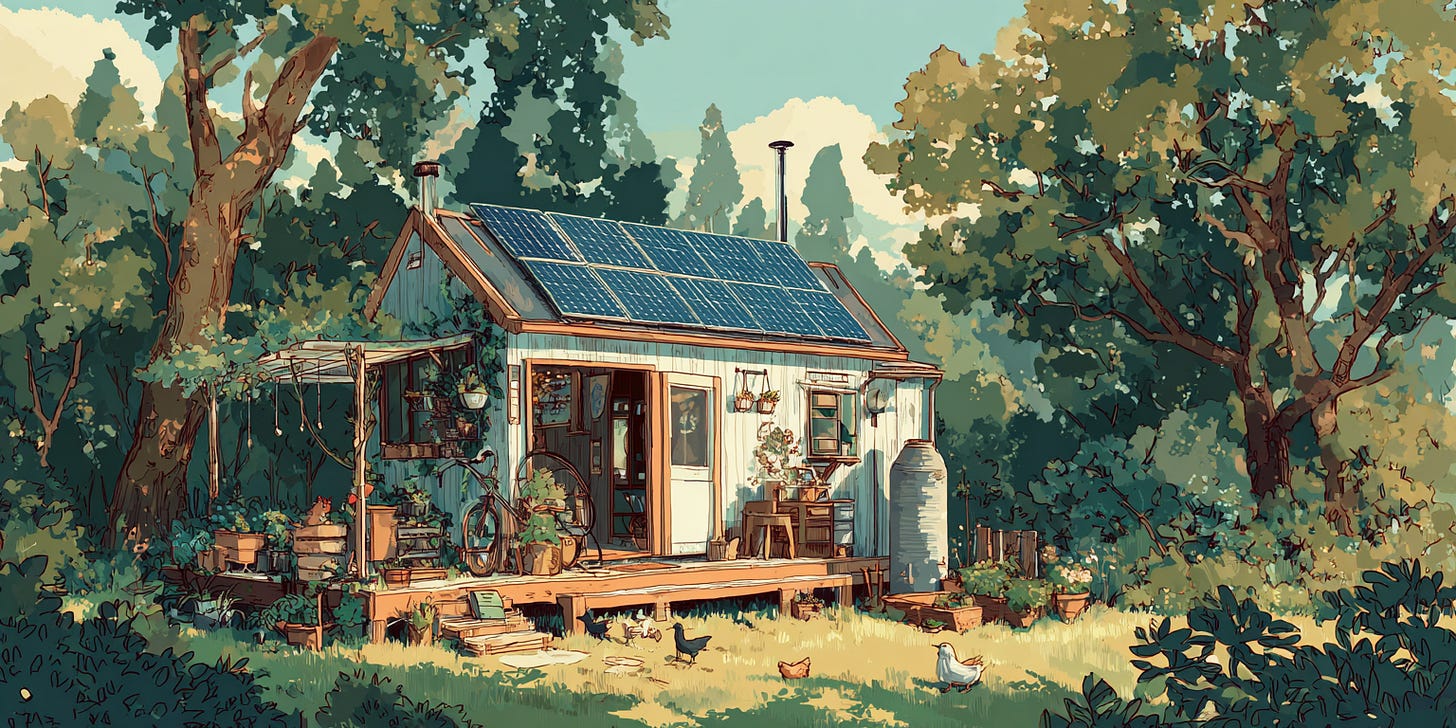A Blueprint for the FreeDood Lifestyle
A realistic path to semi-off-grid living for normal people
Why This Exists
Not everyone wants a 40-acre off-grid compound or a van full of solar panels.
Some of us just want a small patch of earth, a warm roof, coffee in the morning, and bills that don’t require a second life.
This is the blueprint: a ⅓- to ½-acre setup, small enough to manage solo, big enough to breathe. Everything here is built around simplicity, resilience, and financial sanity.
🌍 Land & Setup
Buy land (⅓–½ acre): $15,000–$25,000 (~$300/mo)
Or rent a plot: $300–$500 / month
Property taxes: $300–$700 / year
Site prep (driveway, grading, permits): $500–$2,000
Fence & gate: $300–$800
Deck or platform base: $500–$1,200
Tool shed / lean-to: $500–$1,000
A small patch of dirt is the foundation of freedom. Everything else is optional.
🛖 Shelter
10×20 cabin shed conversion: $10k–$15k
Teardrop camper (DIY/used): $6k–$12k
Canvas yurt / tent: $4k–$8k
Insulation package: $600–$1,000
Mini-split AC/heat: $800–$1,500
Fans, shade, passive cooling: $100–$300
Wood stove / propane heater: $200–$800
You don’t need a mansion—just a structure that stays dry, warm, and honest.
⚡ Power & Light
Grid hookup: $500–$1,500
Solar (1000 W + battery): $2k–$3k
Battery bank (100 Ah): $400–$800
Inverter + controller: $350–$650
LED or USB lights: $50–$150
Power doesn’t have to mean dependence. Sunlight and thrift go a long way.
💧 Water & Waste
City or well hookup: $500–$2,000
Rainwater catchment (500–1000 gal): $600–$1,200
Hauling setup (tote + pump): $200–$400
Filter (Berkey/Sawyer): $100–$350
Composting toilet: $600–$1,200
Greywater system: $300–$800
Outdoor shower: $150–$400
If you can manage water in and water out, you can live almost anywhere.
🍳 Food & Storage
Propane stove: $80–$150
HomeBioGas digester: $1,000–$1,200
Solar oven: $150–$300
Instant Pot: $100
Mini fridge (electric): $150–$400
Propane fridge (off-grid): $800–$1,200
Canner / dehydrator: $75–$200
Food security begins with heat, a lid, and a plan.
🌱 Grow Your Own
Raised beds / planters: $200–$600
Garden tools: $75–$150
Compost bins / worm farm: $100–$200
Seeds & soil: $50–$150
Chicken coop + 3 hens: $400–$800
Feed / fencing: $150–$300
Root cellar: $200–$500
You won’t grow everything, but you can grow something. That’s enough.
🚲 Mobility & Connection
Cargo bike: $2k–$4k
Small car (used): $6k–$12k
Dumb phone: $50
Mint Mobile: $15 /mo
Cell booster / hotspot: $100–$400
Starlink or 5G router: $600 setup / $120 mo
Stay connected enough to work, not enough to lose your peace.
💊 Health & Essentials
Health Cost Share: $119 /mo
First aid kit: $50–$150
Fire extinguisher & smoke alarm: $50–$100
Emergency fund: $3,000–$5,000
Health insurance is nice, but actual health is cheaper.
🧰 Tools & Maintenance
Drill, saw, hammer: $200–$300
Garden tools: $75–$150
Maintenance supplies: $50–$100
Locking storage: $100–$200
Outdoor lighting / trail cam: $50–$200
Tools are the line between independence and helplessness.
🛏️ Comfort & Clothing
Tatami mat or hammock: $150–$250
Blankets / sleeping bag: $100–$250
7 total outfits: ~$300
Rain gear & boots: $100–$200
Everything else is optional. Warmth and dry socks are not.
🧼 Hygiene & Personal
Bamboo toothbrush: $5
Safety razor + blades: $25
Toothpaste (VanMan): $12
Soap & supplies: $20
Mirror: $10
You can be rugged and still smell human.
💵 Monthly Reality Check
Category Cost Land payment or rent $300–$500 Property taxes $30–$60 Power / fuel $40–$80 Phone / Internet $15–$135 Health cost share $119 Food / gas / supplies $200–$400 Total (Grid Life) $700–$1,000 / mo Total (Off-Grid Minimal) $400–$700 / mo
⚙️ Startup Snapshot
Lifestyle Setup Cost Monthly Cost Grid-Connected $25k–$35k $700–$1,000 Off-Grid Optimized $35k–$45k $400–$700 Barebones (rented land + rainwater) $15k–$20k $300–$500
Final Thoughts
A third of an acre.
A small cabin.
A dumb phone, a garden, and a way to heat water.
It’s not glamorous—but it’s free from the treadmill. The Micro-Homestead isn’t about prepping for the apocalypse; it’s about opting out of the absurd.
Because peace and independence shouldn’t require a mortgage.
A few fun ideas beyond the basics:
Stock water swimming pool
Fire pit area for outdoor living
Find land in an off-grid community



Love this blueprint—clear, grounded, and actually doable. Having done a few semi–off-grid projects myself, here are a couple additions that have made the difference between “cute experiment” and “durable life.”
1) Start with community, not hardware.
No one truly lives off-grid; we live on a mesh of human, ecological, and logistical support. Before buying panels or a cabin, map your human stack: 3–5 nearby allies you can swap labor with, a weekly skill-share (repairs, canning, first-aid), and at least one neighbor with a well, tractor, or workshop. Build a micro-co-op for bulk buys (propane, feed, fencing) and an emergency tree for illness/travel. Community is resilience; gear is amplification.
2) Consider geography arbitrage.
What feels “impossible” in one country/region can be straightforward elsewhere. Land prices, permitting, water rights, and cultural norms vary wildly. If your life allows it, explore places where smallholdings, homesteading, and barter are normal. Moving countries seems big, but it can mean more land, better community fit, and dramatically lower total cost of living.
3) Add a real permaculture/food-forest plan (with budget).
Food security isn’t just raised beds—it’s a designed system. Line-item a 3-year plan: soil building, water capture & swales, windbreak/hedgerows, guilded perennials (fruit/nut/medicinals), small livestock, and a nursery corner to propagate your own trees. Include costs for compost, mulch, trees, fencing, irrigation, and tools. Design for medicine and trade too—herb beds, mushrooms, honey/eggs/seedlings as reliable barter.
If you append a “Community & Bioregion” section (allies, co-op buys, skill circle, mutual-aid map) and a “Permaculture Phasing & Costs” table (Year 1 soil/water, Year 2 perennials, Year 3 canopy & surplus), this guide goes from solid to rock-steady. Peace and independence don’t require isolation—they require good neighbors and good design.
What about the FreeDudettes?